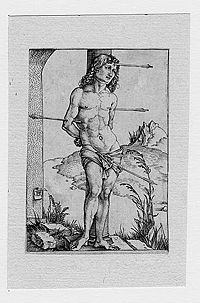
Saint Sebastian at the Column (Dürer)
Encyclopedia

Engraving
Engraving is the practice of incising a design on to a hard, usually flat surface, by cutting grooves into it. The result may be a decorated object in itself, as when silver, gold, steel, or glass are engraved, or may provide an intaglio printing plate, of copper or another metal, for printing...
by the German artist Albrecht Dürer
Albrecht Dürer
Albrecht Dürer was a German painter, printmaker, engraver, mathematician, and theorist from Nuremberg. His prints established his reputation across Europe when he was still in his twenties, and he has been conventionally regarded as the greatest artist of the Northern Renaissance ever since...
(1471–1528), part of his series of the Lives of the Saints.
Dürer intended the work to represent both an idealised vision of 15th-century beauty, and a homage to classical sculpture
Classical sculpture
Classical sculpture refers to the forms of sculpture from Ancient Greece and Ancient Rome, as well as the Hellenized and Romanized civilizations under their rule or influence from about 500 BC to fall of Rome in AD 476. It also refers stylistically to modern sculptures done in a classical style....
. According to legend, Saint Sebastian was martyred by the Roman emperor Diocletian
Diocletian
Diocletian |latinized]] upon his accession to Diocletian . c. 22 December 244 – 3 December 311), was a Roman Emperor from 284 to 305....
for his Christian
Christian
A Christian is a person who adheres to Christianity, an Abrahamic, monotheistic religion based on the life and teachings of Jesus of Nazareth as recorded in the Canonical gospels and the letters of the New Testament...
faith. By the 16th century, artists were using Christian tales as an excuse to portray the humanistic nude body. The four arrows piercing Sebastian's body represent a symbolic wounding of a flawless body. The saint's pose echoes the Crucifixion
Crucifixion
Crucifixion is an ancient method of painful execution in which the condemned person is tied or nailed to a large wooden cross and left to hang until dead...
, and like the saviour, Saint Sebastian is said to have risen from the dead, though in his case to punish those who have persecuted Christians for their beliefs.
The engraving is an early example of the use of contrapposto
Contrapposto
Contrapposto is an Italian term that means counterpose. It is used in the visual arts to describe a human figure standing with most of its weight on one foot so that its shoulders and arms twist off-axis from the hips and legs. This gives the figure a more dynamic, or alternatively relaxed...
in western art, and one of the first depictions of the harmonic balance between opposing forces (in this case between the arrows and the flesh). Dürer encountered such concepts during his travels to north Italy, where he also found the inspiration for the harmonic contrast he renders between Saint Sebastian's engaged leg and his free leg.
Sources
- Nürnberg, Verlag Hans Carl. Dürer in Dublin: Engravings and woodcuts of Albrecht Dürer. Chester Beatty Library, 1983.
- Kurth, Dr. Willi. The complete woodcuts of Albrecht Durer. New York: Arden Book Co, 1935.

